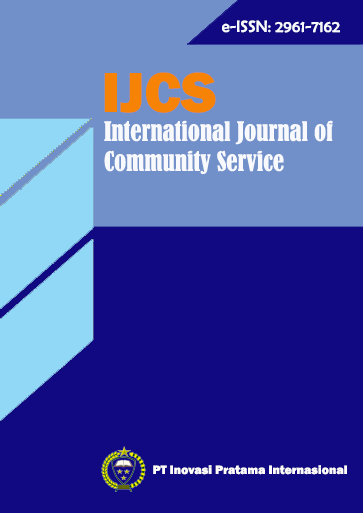Transformation of Tourist Villages into Wellness Destinations Based on Community Participation and Digital Innovation
Main Article Content
Abstract
Kenderan Village in Gianyar Regency, Bali, has great potential as a wellness tourism destination based on local wisdom. The natural beauty, spiritual culture, and traditional practices such as yoga, meditation, and herbal medicine make this village an ideal location for physical, mental, and spiritual health tourism. However, the management of wellness tourism still faces challenges, such as limited digital marketing, lack of tourism management skills, and minimal supporting infrastructure. This Community Service (PKM) activity aims to increase the capacity of the community to manage wellness tourism professionally and sustainably through a participatory approach and digital innovation. This program includes training in digital marketing, branding strategies, homestay management, and the use of digital technology in tourism promotion. In addition, collaboration with academics, government, and wellness practitioners is strengthened to build a community-based tourism ecosystem in Kenderan Village. The results of the program show an increase in community skills in digital marketing and destination management, which contributes to increasing the village's visibility at the national and international levels. The implementation of digital platforms, such as village websites and social media, has succeeded in attracting more wellness tourists. In addition, community participation has increased with the formation of wellness business groups, such as homestay healing, herbal medicine production, and traditional therapy. However, challenges remain, including improving digital and physical infrastructure, certifying wellness instructors, and strengthening the global wellness community network. Long-term strategies such as continued mentoring, private sector collaboration, and replication of this development model in other tourism villages are needed. With the right approach, Kenderan Village has the potential to become a leading wellness tourism destination in Bali, which not only improves community welfare but also provides an authentic healing experience for global tourists.
Downloads
Article Details

This work is licensed under a Creative Commons Attribution 4.0 International License.
References
Central Statistics Agency of Gianyar Regency. (2022). Regional Statistics of Gianyar Regency 2022. BPS Gianyar Regency.
Beeton, S. (2006). Community Development Through Tourism. Landlinks Press.
Blackstock, K. L. (2005). A critical look at community based tourism. Community Development Journal, 40(1), 39–49.
Buhalis, D., & Law, R. (2008). Progress in information technology and tourism management: 20 years on and 10 years after the internet—The state of eTourism research. Tourism Management, 29(4), 609-623. https://doi.org/10.1016/j.tourman.2008.01.005
Buhalis, D., & Law, R. (2008). Progress in information technology and tourism management: 20 years on and 10 years after the Internet—The state of eTourism research. Tourism Management, 29(4), 609–623.
Cohen, M., & Bodeker, G. (2008). Understanding the global spa industry: Spa management. Butterworth-Heinemann.
Dredge, D., & Jenkins, J. (2007). Tourism Planning and Policy. John Wiley & Sons.
Hall, C. M., & Williams, A. M. (2008). Tourism and Innovation. Routledge.
Ministry of Tourism and Creative Economy of the Republic of Indonesia. (2021). Guide to Developing Local Wisdom-Based Tourism Villages. Jakarta: Kemenparekraf.
Ministry of Tourism and Creative Economy of the Republic of Indonesia. (2021). Tourism Village Development Guide. Jakarta: Kemenparekraf RI.
Kotler, P., Bowen, J. T., Makens, J. C., & Baloglu, S. (2017). Marketing for Hospitality and Tourism (7th ed.). Pearson.
Kotler, P., Bowen, J., & Makens, J. (2014). Marketing for Hospitality and Tourism. Pearson.
Lane, B. (2009). Rural tourism: An overview. In Jamal, T. & Robinson, M. (Eds.), The SAGE Handbook of Tourism Studies (pp. 354-370). SAGE Publications.
Lane, B., & Kastenholz, E. (2015). Rural tourism: The evolution of practice and research approaches – towards a new generation concept?. Journal of Sustainable Tourism, 23(8–9), 1133–1156.
Lusch, R.F., & Nambisan, S. (2015). Service innovation: A service-dominant logic perspective. MIS Quarterly, 39(1), 155–175.
Middleton, V. T. C., Fyall, A., Morgan, M., & Ranchhod, A. (2009). Marketing in Travel and Tourism. Butterworth-Heinemann.
Ohe, Y., & Peypoch, N. (2016). Agritourism and the authenticity of the tourist experience in rural areas: The role of farms in Japan. Tourism Management, 59, 571-586. https://doi.org/10.1016/j.tourman.2016.09.010
Purnomo, B., & Rahman, F. (2020). Utilization of Digital Technology in Community-Based Tourism Marketing. Indonesian Tourism Journal, 12(1), 45-60.
Sigala, M. (2018). Implementing social media in tourism destination management: Insights and managerial implications from a Greek case study. Tourism Management, 42, 54-62. https://doi.org/10.1016/j.tourman.2013.11.005
Sigala, M., & Gretzel, U. (2018). Advances in Social Media for Travel, Tourism and Hospitality: New Perspectives, Practice and Cases. Routledge.
Smith, M., & Puczko, L. (2014). Health, Tourism and Hospitality: Spas, Wellness and Medical Travel. London: Routledge.
Suansri, P. (2003). Community-based tourism handbook. Responsible Ecological Social Tour Project (REST).
Suardana, IW (2019). Tourism Village Development Strategy in Bali Based on Local Wisdom. Journal of Tourism Studies, 19(2), 25-39.
Sutanto, A., & Wicaksono, A. (2021). Digitalization in Sustainable Tourism Destination Management. Journal of Tourism Management, 8(1), 75-89.
Tosun, C. (2006). Expected nature of community participation in tourism development. Tourism Management, 27(3), 493–504.
UNWTO. (2020). Tourism and Rural Development: A Policy Perspective. United Nations World Tourism Organization.
UNWTO. (2021). Guidelines for the Development of Sustainable Tourism in Rural Areas. Madrid: United Nations World Tourism Organization.
Wang, Y., & Fesenmaier, D. R. (2007). Collaborative destination marketing: A case study of Elkhart County, Indiana. Tourism Management, 28(3), 863–875.
Wikananda, IK, & Sutrisna, M. (2020). The Role of Community in Developing Tourism Villages in Bali: Case Study in Gianyar Regency. Journal of Social Sciences and Humanities, 9(2), 120-135.
World Tourism Organization (2022). Tourism and Rural Development: Creating Opportunities for Rural Communities. Madrid: UNWTO.
Yachin, J. M. (2018). The entrepreneur–opportunity nexus: Discovering the forces that promote product innovations in rural tourism. Journal of Rural Studies, 62, 242–251.
Yunianto, B., & Suardana, W. (2021). Digital marketing strategies for sustainable tourism village development: A case study of Bali, Indonesia. Journal of Tourism and Sustainability, 9(2), 155-172.

